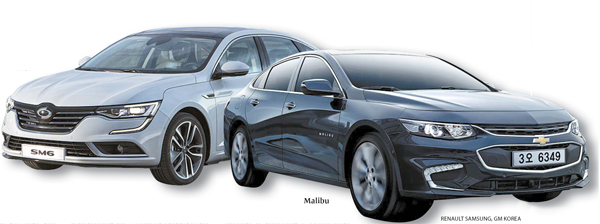No. 1 carmaker losing in sedan market

RENAULT SAMSUNG
The latest releases of Renault Samsung Motors’ SM6 and GM Korea’s Malibu have been celebrated for their size, engines and quality options, and this has hit Hyundai Motor and Kia Motors hard, two companies that have enjoyed safe ground in the midsize sedan market with Hyundai’s Sonata and Kia’s K5.
In March, 6,751 units of the SM6 (known as the “Talisman” in the global market) were sold, which is very close to the 7,053 sales made by Sonata. As a single generation model, the SM6 actually outpaced Sonata. The sales record of the latest Sonata LF model, excluding the previous YF Sonata, was 6,442 units. Sonata took back its crown in April, but considering there weren’t enough supplies of the SM6 to sell in the domestic market, Renault Samsung still has a chance to take another shot at Hyundai.
GM Korea’s flagship sedan, the Malibu, recently hit 10,000 in pre-orders in just eight business days after orders began on April 27. On the first day alone, the Malibu brought in 2,000 pre-orders. It took Kia Motors’ K5 17 business days to surpass 10,000 pre-orders, while it took the SM6 roughly a month.
The surging popularity of the Malibu and the SM6 is partly due to their larger body compared to existing midsize sedans.
The Malibu shows off a body length of 4,925 millimeters (16.2 feet), which is longer than all of its competitors and even 5 millimeters longer than Hyundai Motors’ Grandeur, a full-size sedan. The SM6 has a wheelbase at same length as its full-size sedan, the SM7.
The car’s wheelbase is 2,810 millimeters long, which is 5 millimeters longer than Sonata and Kia Motors’ K5. The longer wheelbase implies that the car displays the look of a midsize sedan on the outside but actually offers interior space on par with that of a full-size sedan.
Engine downsizing is another key to their popularity. The engine is smaller but has greater power, significantly improving the fuel economy and reducing carbon emissions at the same time. The Malibu’s 1.5-liter (o.4 gallon) and 2.0-turbo engine models are a step up from its previous 2.0-liter and 2.4-liter naturally-aspirated engines. A turbo engine, or turbocharger, is a forced-induction device, unlike naturally-aspirated engines, that enhances engine function, which is how smaller engines can have stronger output. More than 60 percent of the Malibu’s pre-orders were made on 1.5-liter turbo engine model.
The SM6 also released models in only two gasoline-engine types, the 1.6-liter and the 2.0-liter options. The size of the 1.6-liter engine is the same as that of Hyundai Motor’s Avante, a compact sedan.
High-quality options make these models even more attractive. A single button on the SM6 offers five different driving experiences: sport, comfort, eco, normal and personal. Depending on the mode selected, engine features, dashboard lights, interior lights and even the seats and supportive systems will change. Other provided options include Active Damping Control, Head-Up Display, 360-degree parking sensors and full LED head lamps. The Malibu also added various options to its design, such as Active Noise Cancellation, which reduces noise while driving.
Market leaders such as Hyundai Motor and Kia Motors may be in tension due to a revival of strong competition, but the overall midsize sedan market is enjoying a boom after being robbed of its popularity by sport utility vehicles (SUVs). In 2011, midsize sedan sales made up about 22.3 percent of the domestic automotive market, but this fell to 16 percent last year. In February of this year, the numbers further dived to 13.4 percent.
Then in March, market shares bounced back to 16.5 percent, right after the launch of the SM6 in late February. As pre-orders for the Malibu began in April and actual sales for the model is due to begin in May 19, midsize sedans are likely to take up a bigger portion of the Korean automotive market this month, according to industry insiders.
“Local automakers, once beaten up by Hyundai and Kia, are now making a strategic move in the domestic sedan market,” said Kim Pil-soo, automotive engineering professor at Daelim Univeristy. “I expect to see solid competition in the sedan market, which used to be dominated by Sonata.”
BY KIM JEE-HEE, KIM KI-HWAN [kim.jeehee@joongang.co.kr]










with the Korea JoongAng Daily
To write comments, please log in to one of the accounts.
Standards Board Policy (0/250자)